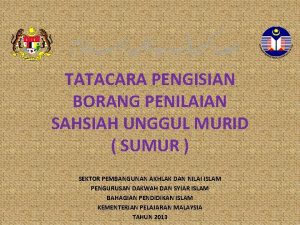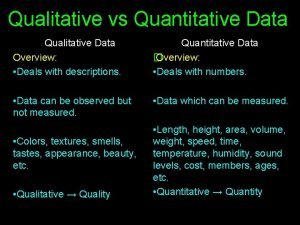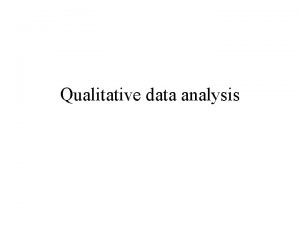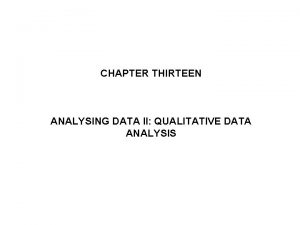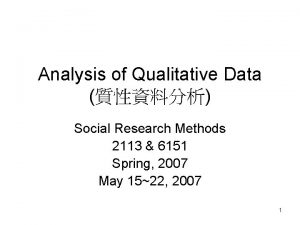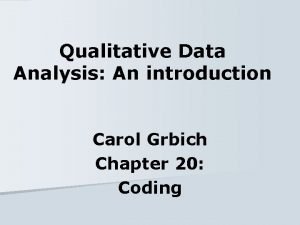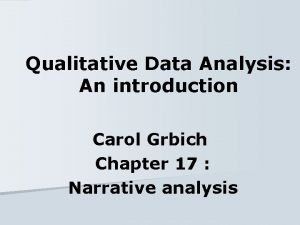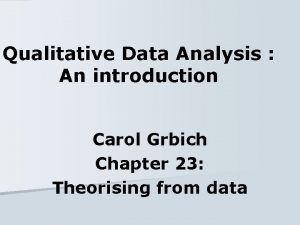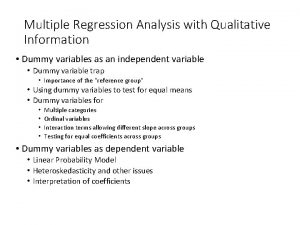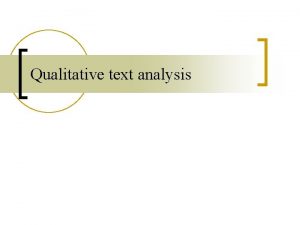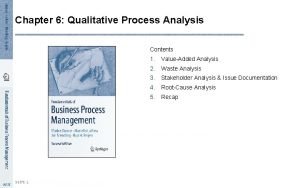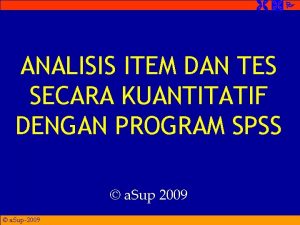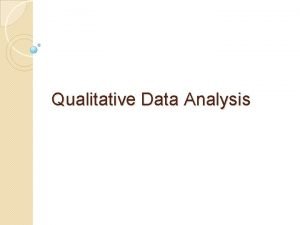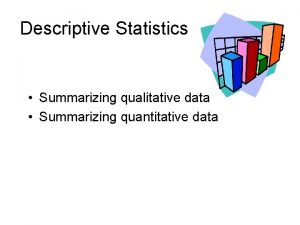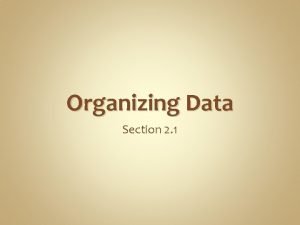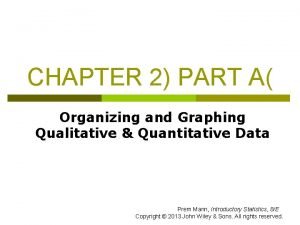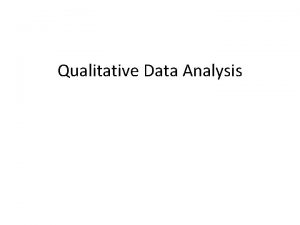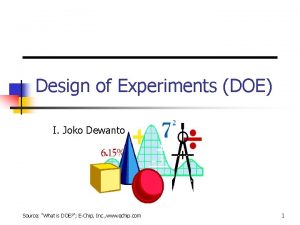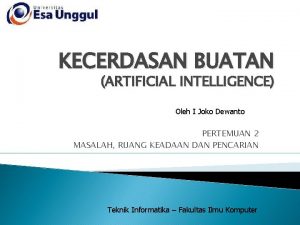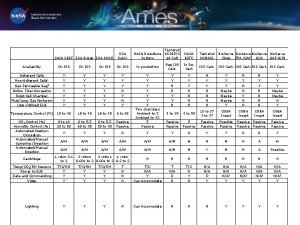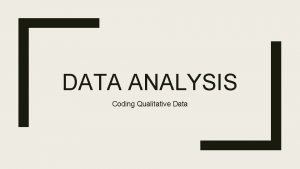Qualitative Data Analysis I Joko Dewanto Esa Unggul




























![Example: Calendar Contents • Step 2: go through data and ask questions [FO] Types Example: Calendar Contents • Step 2: go through data and ask questions [FO] Types](https://slidetodoc.com/presentation_image_h/00d945b1661808b71b0657b8fa4a5c6b/image-29.jpg)
![Example: Calendar Contents • Step 2: go through data and ask questions [FO] Types Example: Calendar Contents • Step 2: go through data and ask questions [FO] Types](https://slidetodoc.com/presentation_image_h/00d945b1661808b71b0657b8fa4a5c6b/image-30.jpg)
![Example: Calendar Contents • Step 2: go through data and ask questions [FO] Types Example: Calendar Contents • Step 2: go through data and ask questions [FO] Types](https://slidetodoc.com/presentation_image_h/00d945b1661808b71b0657b8fa4a5c6b/image-31.jpg)







































- Slides: 70

Qualitative Data Analysis I. Joko Dewanto Esa Unggul University

Outline • Qualitative research • Analysis methods • Validity and generalizability

Qualitative Research Methods • Interviews • Ethnographic interviews (Spradley, 1979) • Contextual interviews (Holtzblatt and Jones, 1995) • Ethnographic observation (Spradley, 1980) • Participatory design sessions • Field deployments (Sanders, 2005)

Qualitative Research Goals • Meaning: how people see the world • Context: the world in which people act • Process: what actions and activities people do • Reasoning: Maxwell, 2005 why people act and behave the way they do

Quantitative vs. Qualitative • Explanation through numbers • Explanation through words • Objective • Subjective • Deductive reasoning • Inductive reasoning • Predefined variables and measurement • Creativity, extraneous variables • Data collection before analysis • Data collection and analysis intertwined • Cause and effect relationships • Description, meaning Ron Wardell, EVDS 617 course notes

Quantitative vs. Qualitative • Explanation through numbers • Explanation through words • Objective • Subjective • Deductive reasoning • Inductive reasoning • Predefined variables and measurement • Creativity, extraneous variables • Data collection before analysis • Data collection and analysis intertwined • Cause and effect relationships • Description, meaning Ron Wardell, EVDS 617 course notes

Quantitative vs. Qualitative • Explanation through numbers • Explanation through words • Objective • Subjective • Deductive reasoning • Inductive reasoning • Predefined variables and measurement • Creativity, extraneous variables • Data collection before analysis • Data collection and analysis intertwined • Cause and effect relationships • Description, meaning Ron Wardell, EVDS 617 course notes

Quantitative vs. Qualitative • Explanation through numbers • Explanation through words • Objective • Subjective • Deductive reasoning • Inductive reasoning • Predefined variables and measurement • Creativity, extraneous variables • Data collection before analysis • Data collection and analysis intertwined • Cause and effect relationships • Description, meaning Ron Wardell, EVDS 617 course notes

Quantitative vs. Qualitative • Explanation through numbers • Explanation through words • Objective • Subjective • Deductive reasoning • Inductive reasoning • Predefined variables and measurement • Creativity, extraneous variables • Data collection before analysis • Data collection and analysis intertwined • Cause and effect relationships • Description, meaning Ron Wardell, EVDS 617 course notes

Quantitative vs. Qualitative • Explanation through numbers • Explanation through words • Objective • Subjective • Deductive reasoning • Inductive reasoning • Predefined variables and measurement • Creativity, extraneous variables • Data collection before analysis • Data collection and analysis intertwined • Cause and effect relationships • Description, meaning Ron Wardell, EVDS 617 course notes

Quantitative vs. Qualitative • Explanation through numbers • Explanation through words • Objective • Subjective • Deductive reasoning • Inductive reasoning • Predefined variables and measurement • Creativity, extraneous variables • Data collection before analysis • Data collection and analysis intertwined • Cause and effect relationships • Description, meaning Ron Wardell, EVDS 617 course notes

Getting ‘Good’ Qualitative Results • Depends on: • The quality of the data collector • The quality of the data analyzer • The quality of the presenter / writer Ron Wardell, EVDS 617 course notes

Qualitative Data • Written field notes • Audio recordings of conversations • Video recordings of activities • Diary recordings of activities / thoughts

Qualitative Data • Depth information on: • thoughts, views, interpretations • priorities, importance • processes, practices • intended effects of actions • feelings and experiences Ron Wardell, EVDS 617 course notes

Outline • Qualitative research • Analysis methods • Validity and generalizability

Data Analysis • Open Coding • Systematic Coding • Affinity Diagramming

Open Coding • Treat data as answers to open-ended questions • ask data specific questions • assign codes for answers • record theoretical notes Strauss and Corbin, 1998, Ron Wardell, EVDS 617 course notes

Example: Calendar Routines • Families were interviewed about their calendar routines • • What calendars they had Where they kept their calendars What types of events they recorded … • Written notes • Audio recordings Neustaedter, 2007

Example: Calendar Routines • Step 1: translate field notes paper (optional) digital

Example: Calendar Routines • Step 2: list questions / focal points Where do families keep their calendars? What uses do they have for their calendars? Who adds to the calendars? When do people check the calendars? … (you may end up adding to this list as you go through your data)

Example: Calendar Routines • Step 3: go through data and ask questions Where do families keep their calendars?

Example: Calendar Routines • Step 3: go through data and ask questions Calendar Locations: [KI] Where do families keep their calendars? [KI] – the kitchen

Example: Calendar Routines • Step 3: go through data and ask questions Calendar Locations: [KI] [CR] Where do families keep their calendars? [KI] – the kitchen [CR] – child’s room

Example: Calendar Routines • Step 3: go through data and ask questions Calendar Locations: [KI] [CR] Continue for the remaining questions…. [KI] – the kitchen [CR] – child’s room

Example: Calendar Routines • The result: • list of codes • frequency of each code • a sense of the importance of each code • frequency != importance

Example 2: Calendar Contents • Pictures were taken of family calendars Neustaedter, 2007

Example: Calendar Contents • Step 1: list questions / focal points What type of events are on the calendar? Who are the events for? What other markings are made on the calendar? … (you may end up adding to this list as you go through your data)

Example: Calendar Contents • Step 2: go through data and ask questions What types of events are on the calendar?
![Example Calendar Contents Step 2 go through data and ask questions FO Types Example: Calendar Contents • Step 2: go through data and ask questions [FO] Types](https://slidetodoc.com/presentation_image_h/00d945b1661808b71b0657b8fa4a5c6b/image-29.jpg)
Example: Calendar Contents • Step 2: go through data and ask questions [FO] Types of Events: [FO] – family outing What types of events are on the calendar?
![Example Calendar Contents Step 2 go through data and ask questions FO Types Example: Calendar Contents • Step 2: go through data and ask questions [FO] Types](https://slidetodoc.com/presentation_image_h/00d945b1661808b71b0657b8fa4a5c6b/image-30.jpg)
Example: Calendar Contents • Step 2: go through data and ask questions [FO] Types of Events: [FO] – family outing [AN] - anniversary [AN] What types of events are on the calendar?
![Example Calendar Contents Step 2 go through data and ask questions FO Types Example: Calendar Contents • Step 2: go through data and ask questions [FO] Types](https://slidetodoc.com/presentation_image_h/00d945b1661808b71b0657b8fa4a5c6b/image-31.jpg)
Example: Calendar Contents • Step 2: go through data and ask questions [FO] Types of Events: [FO] – family outing [AN] - anniversary [AN] Continue for the remaining questions….

Reporting Results • Find the main themes • Use quotes / scenarios to represent them • Include counts for codes (optional)

Software: Microsoft Word

Software: Microsoft Excel

Software: ATLAS. ti http: //www. atlasti. com/ -- free trial available

Data Analysis • Open Coding • Systematic Coding • Affinity Diagramming

Systematic Coding • Categories are created ahead of time • from existing literature • from previous open coding • Code the data just like open coding Ron Wardell, EVDS 617 course notes

Data Analysis • Open Coding • Systematic Coding • Affinity Diagramming

Affinity Diagramming • Goal: what are the main themes? • Write ideas on sticky notes • Place notes on a large wall / surface • Group notes hierarchically to see main themes Holtzblatt et al. , 2005

Example: Calendar Field Study • Families were given a digital calendar to use in their homes • Thoughts / reactions recorded: • Weekly interview notes • Audio recordings from interviews Neustaedter, 2007

Example: Calendar Field Study • Step 1: Affinity Notes • go through data and write observations down on post-it notes • each note contains one idea

Example: Calendar Field Study • Step 2: Diagram Building • place all notes on a wall / surface

Example: Calendar Field Study • Step 3: Diagram Building • move notes into related columns / piles

Example: Calendar Field Study • Step 3: Diagram Building • move notes into related columns / piles

Example: Calendar Field Study • Step 3: Diagram Building • move notes into related columns / piles

Example: Calendar Field Study • Step 3: Diagram Building • move notes into related columns / piles

Example: Calendar Field Study • Step 3: Diagram Building • move notes into related columns / piles

Example: Calendar Field Study • Step 3: Diagram Building • move notes into related columns / piles

Example: Calendar Field Study • Step 3: Diagram Building • move notes into related columns / piles

Example: Calendar Field Study • Step 4: Affinity Labels • write labels describing each group

Example: Calendar Field Study • Step 4: Affinity Labels • write labels describing each group Calendar placement is a challenge

Example: Calendar Field Study • Step 4: Affinity Labels • write labels describing each group Calendar placement is a challenge Interface visuals affect usage

Example: Calendar Field Study • Step 4: Affinity Labels • write labels describing each group Calendar placement is a challenge Interface visuals affect usage People check the calendar when not at home

Example: Calendar Field Study • Step 5: Further Refine Groupings • see Holtzblatt et al. 2005 Calendar placement is a challenge Interface visuals affect usage People check the calendar when not at home

Outline • Qualitative research • Analysis methods • Validity and generalizability

Validity Threats • Bias • researcher’s influence on the study • e. g. , studying one’s own culture • Reactivity • researcher's effect on the setting or people • e. g. , people may do things differently Maxwell, 2005

Validity Tests • Intensive / long term • Negative cases • Rich data • Triangulation • Respondent validation • Quasi-statistics • Intervention • Comparison Maxwell, 2005

Validity Tests • Intensive / long term • Negative cases • Rich data • Triangulation • Respondent validation • Quasi-statistics • Intervention • Comparison Maxwell, 2005

Validity Tests • Intensive / long term • Negative cases • Rich data • Triangulation • Respondent validation • Quasi-statistics • Intervention • Comparison Maxwell, 2005

Validity Tests • Intensive / long term • Negative cases • Rich data • Triangulation • Respondent validation • Quasi-statistics • Intervention • Comparison Maxwell, 2005

Validity Tests • Intensive / long term • Negative cases • Rich data • Triangulation • Respondent validation • Quasi-statistics • Intervention • Comparison Maxwell, 2005

Validity Tests • Intensive / long term • Negative cases • Rich data • Triangulation • Respondent validation • Quasi-statistics • Intervention • Comparison Maxwell, 2005

Validity Tests • Intensive / long term • Negative cases • Rich data • Triangulation • Respondent validation • Quasi-statistics • Intervention • Comparison Maxwell, 2005

Validity Tests • Intensive / long term • Negative cases • Rich data • Triangulation • Respondent validation • Quasi-statistics • Intervention • Comparison Maxwell, 2005

Validity Tests • Intensive / long term • Negative cases • Rich data • Triangulation • Respondent validation • Quasi-statistics • Intervention • Comparison Maxwell, 2005

Generalizability • Internal generalizability • do findings extend within the group studied? • External generalizability • do findings extend outside the group studied? • Face generalizability • there is no reason to believe the results don’t generalize Maxwell, 2005

Summary • Qualitative goals: • meaning, context, process, reasoning • Good qualitative research: • data collector / analyzer / presenter

Summary • Qualitative data: • detailed descriptions (audio, written, video) • Analysis methods: • open coding • systematic coding • affinity diagramming

Summary • Report descriptions / scenarios / quotes • Look for face generalizability • Use validity tests

References 1. Dix, A. , Finlay, J. , Abowd, G. , & Beale, R. , (1998) Human Computer Interaction, 2 nd ed. Toronto: Prentice-Hall. 2. Holtzblatt, K, and Jones, S. , (1995) Conducting and Analyzing a Contextual Interview, In Readings in Human-Computer Interaction: Toward the Year 2000 , 2 nd ed. , R. M. Baecker, et al. , Editors, Morgan Kaufman, pp. 241 -253. - Chapter 11: qualitative methods in general - conducting and analyzing contextual interviews 3. Holtzblatt, K, Wendell, J. , and Wood, S. , (2005) Rapid Contextual Design: A How-To Guide to Key Techniques for User. Centered Design, Morgan Kaufmann. - Chapter 8: building affinity diagrams 4. Maxwell, J. , (2005) Qualitative Research Design, In Applied Social Research Methods Series , Volume 41. - Chapter 1: a model for qualitative research design - Chapter 5: choosing qualitative methods and analysis - Chapter 6: validity and generalizability 5. Neustaedter, C. 2007. Domestic Awareness and Family Calendars, Ph. D Dissertation, University of Calgary, Canada. - example qualitative studies, analysis, and results reporting 6. Sanders, E. B. 1999. From User-Centered to Participatory Design Approaches, In Design and Social Sciences, J. Frascara (Ed. ), Taylor and Francis Books Limited. - participatory design for idea generation 7. Spradley, J. (1979) The Ethnographic Interview, Holt, Rinehart & Winston. - Part 2, Step 2: interviewing an informant - Part 2, Step 5: analyzing ethnographic interviews • Spradley, J. , (1980) Participant Observation, Harcourt Brace Jovanovich. - Part 2, Step 2: doing participant observation - Part 2, Step 3: making an ethnographic record • Strauss, A. , and Corbin, J. , (1998). Basics of Qualitative Research: Techniques and Procedures for Developing Grounded Theory, SAGE Publications. - Part 2: coding procedures
 Ktm esa unggul
Ktm esa unggul Bap esa unggul
Bap esa unggul Nim esa unggul
Nim esa unggul Kesehatan masyarakat esa unggul
Kesehatan masyarakat esa unggul Esa multimedia.esa.int./multimedia/virtual-tour-iss
Esa multimedia.esa.int./multimedia/virtual-tour-iss Joko energy
Joko energy Joko waluyo ugm
Joko waluyo ugm Joko email
Joko email Joko email
Joko email Joko nurkamto
Joko nurkamto Coba gaweya cengkorongan utawa kerangka pawarta
Coba gaweya cengkorongan utawa kerangka pawarta Perjamuan khong guan
Perjamuan khong guan Joko tri saputro
Joko tri saputro Joko tri saputro
Joko tri saputro Joko purwanto uny
Joko purwanto uny Maksud mutadayyin
Maksud mutadayyin Modul sumur
Modul sumur Pt bhakti unggul teknovasi
Pt bhakti unggul teknovasi Membina sahsiah unggul
Membina sahsiah unggul Transformasi budaya unggul dan berkarakter
Transformasi budaya unggul dan berkarakter Example of qualitative vs quantitative
Example of qualitative vs quantitative Qualitative vs quantitative data analysis
Qualitative vs quantitative data analysis Principles of qualitative data analysis
Principles of qualitative data analysis Qualitative vs quantitative data analysis
Qualitative vs quantitative data analysis Analysis plan
Analysis plan Miles and huberman 1994
Miles and huberman 1994 Characteristics of qualitative research design
Characteristics of qualitative research design Data
Data Which of the following is an example of quantitative
Which of the following is an example of quantitative Qualitative research
Qualitative research Qualitative data analysis
Qualitative data analysis Qualitative data analysis
Qualitative data analysis Qualitative data analysis
Qualitative data analysis Chapter 10 qualitative data analysis
Chapter 10 qualitative data analysis Holistic perspective in qualitative research
Holistic perspective in qualitative research Power bi for qualitative data
Power bi for qualitative data Qualitative test for lipid
Qualitative test for lipid Benedict's test mechanism
Benedict's test mechanism Qualitative analysis of organic functional groups
Qualitative analysis of organic functional groups Multiple regression analysis with qualitative information
Multiple regression analysis with qualitative information General chemistry with qualitative analysis
General chemistry with qualitative analysis What are qualitative skills
What are qualitative skills Semi qualitative analysis definition
Semi qualitative analysis definition Qualitative text analysis
Qualitative text analysis Political science methodology
Political science methodology Iodine test for starch
Iodine test for starch Complex sugars
Complex sugars Qualitative process analysis
Qualitative process analysis Fructose is non reducing sugar
Fructose is non reducing sugar Induction chemistry
Induction chemistry Item difficulty adalah
Item difficulty adalah Qualitative analysis chemistry
Qualitative analysis chemistry Rapid qualitative analysis
Rapid qualitative analysis Qualitative analysis
Qualitative analysis What is deductive coding
What is deductive coding Qualitative analysis anion
Qualitative analysis anion Domain analysis qualitative research
Domain analysis qualitative research Quantitative chemistry igcse
Quantitative chemistry igcse Is a bipolar survey qualitative or quantitative
Is a bipolar survey qualitative or quantitative Examples of qualitative data
Examples of qualitative data Quantitative data biology definition
Quantitative data biology definition Example of qualitative data
Example of qualitative data Difference between qualitative and quantative data
Difference between qualitative and quantative data How to graph qualitative data
How to graph qualitative data Data collection instruments in qualitative research
Data collection instruments in qualitative research Qualitative data ap human geography definition
Qualitative data ap human geography definition Qualitative secondary data
Qualitative secondary data Transcribing data in qualitative research
Transcribing data in qualitative research Organizing qualitative data
Organizing qualitative data Graphing qualitative data
Graphing qualitative data Qualitative
Qualitative















